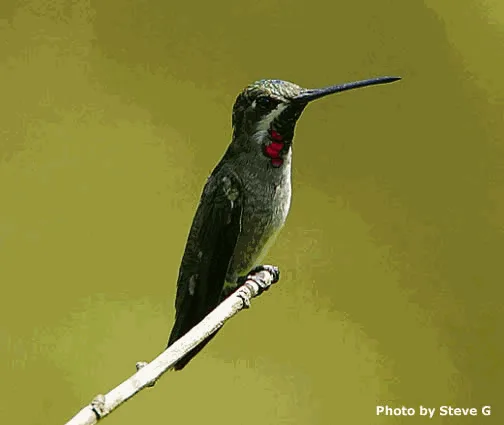 Long-billed Starthroat [order] Apodiformes | [family] Trochilidae | [latin] Heliomaster longirostris | [UK] Long-billed Starthroat | [FR] Colibri corinne | [DE] Rosenkehlkolibri | [ES] Colibri Piquilargo | [IT] Gola stellata beccolungo | [NL] Langsnavel-sterkeelkolibrie Subspecies
Physical charateristicsThe Long-billed Starthroat is 10-11 cm long and weighs 6.8 g. The black bill is straight and very long, at about 3.5 cm. The male has bronze-green upperparts, a blue crown, white moustachial stripe and reddish throat. The underparts are grey shading to white on the flanks and mid-belly, and the tail is mainly black. The female is similar, but has a green crown and a purple-edged black throat. Listen to the sound of Long-billed Starthroat [audio:http://www.aviflevoland.nl/sounddb/L/Long-billed Starthroat.mp3]
RangeThe Long-billed Starthroat, Heliomaster longirostris, is a hummingbird that breeds from southern Mexico to Panama, from Colombia south and east to Bolivia and Brazil, and on Trinidad. In Suriname only known from Sipaliwini savanna. HabitatInhabits forest, and is usually seen in woodland clearings, but will sometimes visit gardens. ReproductionNest is a broad cup mad of mostly moss and copweb, decorated with lichen. Usually placed on an exposed branch of a dead tree, about 10 meter above ground. Clutch size is 2 eggs, incubated by female for about 18 days. Young flegde after about 25 days. Female will feed young for another 3 weeks after fledging. Rarely a second brood. Feeding habitsLong-billed Starthroats feed on nectar, taken from a variety of flowers, and some insects, mostly flies and gnats but also anthropods. It traplines trees over a wide aera and will defend flowering trees. ConservationThis species has a large range, with an estimated global extent of occurrence of 8,300,000 km2. The global population size has not been quantified, but the species is not believed to approach the thresholds for the population size criterion of the IUCN Red List (i.e., less than 10,000 mature individuals in conjunction with appropriate decline rates and subpopulation qualifiers), even though the species is described as ‘uncommon’ in at least parts of its range (Stotz et al. 1996). Global population trends have not been quantified, but the species is not believed to approach the thresholds for the population decline criterion of the IUCN Red List (i.e., declining more than 30% in ten years or three generations). For these reasons, the species is evaluated as Least Concern.  MigrationNot much known, disappears from certain regions in a unpredictable fashion. Seems to be correlated to flowering seasons. Distribution map |
]]>
